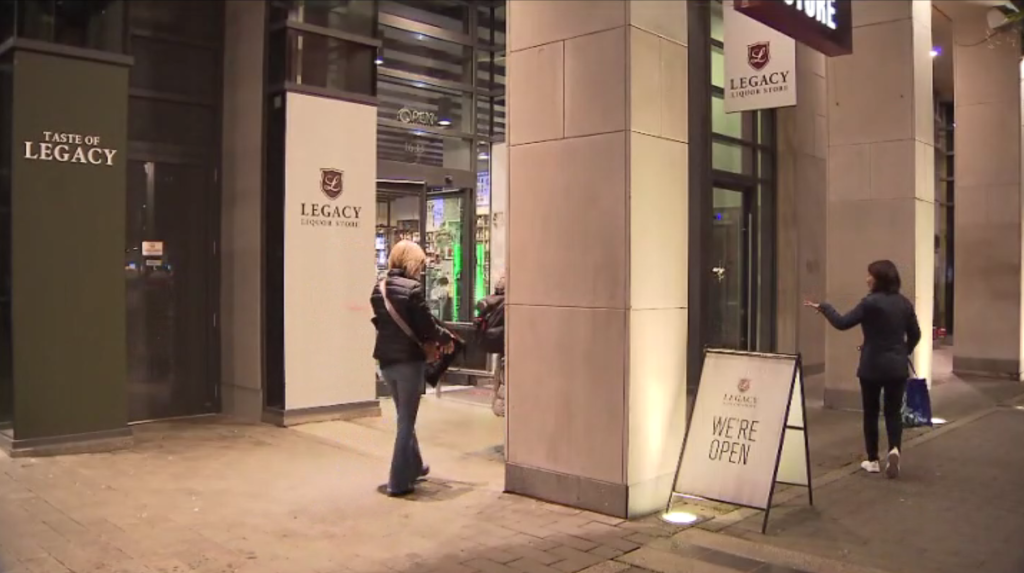Cities look to copy Montreal’s ban of right turns on red, but safety data lacking

Posted November 12, 2023 4:00 am.
Last Updated November 12, 2023 11:15 am.
In an effort to prevent pedestrian and cyclist deaths, more North American cities are contemplating imitating Montreal by banning drivers from turning right on red lights.
But despite decades of debate, even traffic safety advocates who favour the ban say there’s a lack of reliable data proving the measure improves safety.
Valerie Smith, the director of road safety and safe mobility programs at injury prevention group Parachute, said allowing drivers to turn right at red lights creates a “hostile environment” for pedestrians and cyclists — especially children, older seniors and people with mobility problems. She said it forces pedestrians to contend with distracted drivers and gauge whether an approaching driver will stop for them.
“When I consider the potential opportunities for collisions, for serious injuries resulting from those collisions or deaths, I think that it really makes sense to consider strongly a ban on right turns on red,” she said in a phone interview from Creemore, Ont.
Montreal is the only major Canadian city that systematically bans right turns on red lights, while New York City is the only major American one to ban them in most places. But that’s changing.
As The Associated Press reported this month, a number of cities have either voted to restrict the manoeuvre or are debating doing so, including Washington, D.C., Chicago and Ann Arbor, Mich.
In Canada, there has occasionally been pushback against right turn prohibitions. In late 2016, the mayors of 15 suburban Montreal municipalities lobbied unsuccessfully to do away with the ban, citing dropping rates of road fatalities and arguing that Quebec motorists were no more dangerous than those in the rest of North America.
Toronto also debated imposing a blanket ban on right turns on red (RTOR) as part of its Vision Zero strategy, which aims to eliminate pedestrian and cyclist deaths, but opted instead to implement the measure only at selected intersections.
The city “found there would be a potential safety benefit at some locations, but that at other locations, introducing RTOR prohibitions may result in less safe conditions for people walking and cycling,” the city’s media relations department said in an email.
The reasons against a ban cited in the report include the fact that it “inevitably concentrates the entire volume of right-turning vehicle demand to the green phase of the signal” and in some cases could increase conflicts at crossings with higher pedestrian volumes.
Nicolas Saunier, a civil engineering professor at Polytechnique Montréal, said it’s “not clear” whether right-on-red bans are statistically safer in preventing pedestrian and cyclist injuries and deaths.
He leans instead toward favouring any measure that can make the most at-risk road users even a little safer and that encourages people to walk and cycle in confidence.
Road safety advocates, including pedestrian advocacy group Pietons Québec, argue that people die when right turns on red are allowed. The province legalized the manoeuvre outside the island of Montreal in 2003, and the group says it led to seven pedestrian deaths and 37 serious injuries between that year and 2015. Advocates say many drivers fail to follow the rules that require them to come to a full stop before turning, and larger vehicles such as SUVs pose bigger risks to pedestrians.
Both Saunier and Smith say a lack of modern, comprehensive studies on the safety of right turns on red lights remains a barrier to cities considering implementing new rules.
Saunier said this might be, in part, because accidents are rare and involve several variables, including traffic signals and driver behaviour. “There have to be a lot of factors that come together to produce an accident, so it fluctuates a lot,” he said.
Smith said existing studies have found that banning red light turns decreases negative interactions between vehicles and pedestrians or cyclists. However, these studies tend to be small-scale and from a single jurisdiction rather than a systematic review and don’t often measure serious injuries or deaths.
“While we believe it makes sense to implement the no-right-turn-on-red ban, and we know that it’s going to protect the vulnerable road user, we want data to support that,” she said.
Such data, she said, could help cities decide whether to ban turns on red lights at some busy intersections or bring in a blanket ban. A blanket ban, she acknowledges, could be a hard sell in neighbourhoods with few pedestrians where drivers wanting to turn would be frustrated to be stuck sitting at red lights.
“Does that blanket ban make sense from a vulnerable road user perspective? I would say yes,” she said. “But for a city planner who’s trying to meet the needs of a variety of constituents, it’s going to be a little bit more challenging.”








